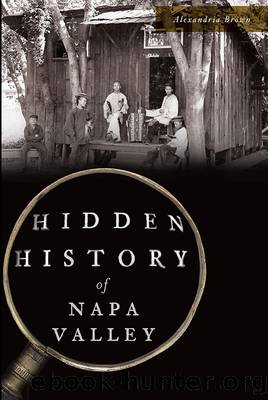Hidden History of Napa Valley by Alexandria Brown

Author:Alexandria Brown
Language: eng
Format: epub
Publisher: Arcadia Publishing Inc.
Published: 2019-12-15T00:00:00+00:00
18
MAKING A HOME
Many ex-braceros made their homes in the county. Ramon Verdin grew up in Guanajuato, Mexico, and became a bracero when he was nineteen. He came to Napa Valley in the mid-1940s, married Socorro Madrigal in 1947 and worked on Cairns Ranch for the rest of his adult life. Ignacio Gallegos left his small hometown of El Llano, Michoacán, to work as a bracero. He made it to Napa Valley in the 1950s and earned citizenship in the 1960s. Ignacio spent the rest of his career at Beringer, first in the vineyards and later as a bottling line supervisor. In 2008, his son, Ignacio Jr., established Gallegos Vineyards, and three years later, Ignacio started producing his own wine.
Rafael Rios was seventeen when he left El Llano to join the Bracero Program. Before landing a gig pruning vines and picking grapes at Frank Wood and Sons Vineyard Management in St. Helena, he picked cotton in Arizona, grapefruit and oranges in Indio, pears in Cortland and tomatoes in Woodland. Eventually, Wood hired him permanently. Rios married, and he and his wife, Ofelia, raised several children together. The California Human Development Corporation, an organization that assists farmworkers and low-income people, honored Rafael Rios in 1999 with the Campesino del Año award.
In the 1940s, Timothy Reyes left Indaparapeo, Michoacán, on a bracero contract after seeing other braceros return wearing nice clothes. His family was very poor, and the chance to earn more money than he ever could back at home was too enticing. He arrived at Stagâs Leap in 1945 and pruned vines. After the war, Reyes went back to Napa and got a job at Beaulieu. Reyes spent the last twenty-five years of his working life as a golf-course groundskeeper at Silverado Country Club.
To provide for his family, Feliciano âChanoâ De Haro left his tiny rural hometown of Los Haro, Jerez, Zacatecas, and entered the Bracero Program. He was sent to Washington to pick apples and to Texas to pick cotton. After their contract for picking pears in Suisun ended, Chano, his brothers-in-law Enrique Segura and José Manuel SaldÃvar and his cousin Rafael SaldÃvar went to Krug to finish the harvest. The work was hard, but the pay was goodâeighty-five cents per hour, twenty cents higher than their previous wage. Once the harvest was done, José Manuel and Rafael returned to Mexico while Chano and Enrique took eighteen-month contracts at Krug.
While on a break at a local bar, Chano ran into Manuel Aguilar, a long-lost uncle who left Zacatecas during the revolution and never returned. Aguilar worked as a groundskeeper at Beringer and relished the chance to reconnect with his relatives. Chano sent for his wife, Juanita, and adopted son, Oscar, and they made a life in Napa Valley. Cesare and Rosa Mondavi, affectionately known as Cesario and Mama, happily sponsored Chanoâs citizenship. When he was older, Oscar spent summer vacations as a seasonal farm worker, and today he is the vice president of student services at Napa Valley College.
Also from Jerez were brothers and braceros ElÃas, Luis and Angel Hurtado.
Download
This site does not store any files on its server. We only index and link to content provided by other sites. Please contact the content providers to delete copyright contents if any and email us, we'll remove relevant links or contents immediately.
Shoot Sexy by Ryan Armbrust(17657)
Portrait Mastery in Black & White: Learn the Signature Style of a Legendary Photographer by Tim Kelly(16953)
Adobe Camera Raw For Digital Photographers Only by Rob Sheppard(16904)
Photographically Speaking: A Deeper Look at Creating Stronger Images (Eva Spring's Library) by David duChemin(16622)
Bombshells: Glamour Girls of a Lifetime by Sullivan Steve(13973)
Art Nude Photography Explained: How to Photograph and Understand Great Art Nude Images by Simon Walden(12975)
Perfect Rhythm by Jae(5324)
Pillow Thoughts by Courtney Peppernell(4208)
The Book of Joy by Dalai Lama(3899)
Good by S. Walden(3487)
The Pixar Touch by David A. Price(3364)
A Dictionary of Sociology by Unknown(3031)
Fantastic Beasts: The Crimes of Grindelwald by J. K. Rowling(2994)
Humans of New York by Brandon Stanton(2835)
Stacked Decks by The Rotenberg Collection(2812)
Read This If You Want to Take Great Photographs by Carroll Henry(2663)
On Photography by Susan Sontag(2575)
Insomniac City by Bill Hayes(2498)
Photographic Guide to the Birds of Indonesia by Strange Morten;(2490)
